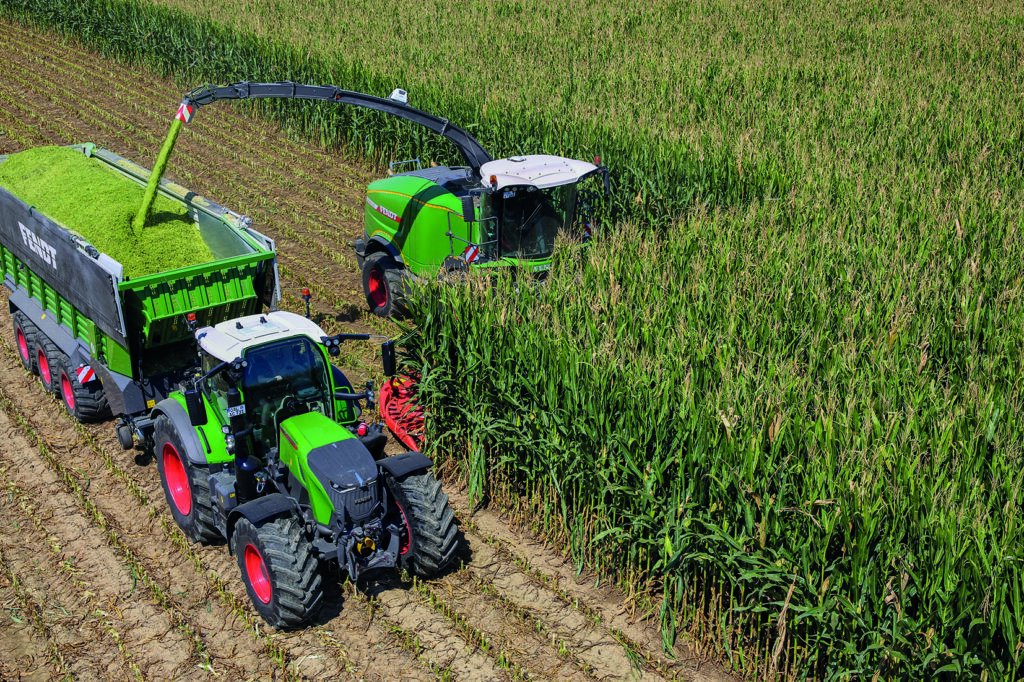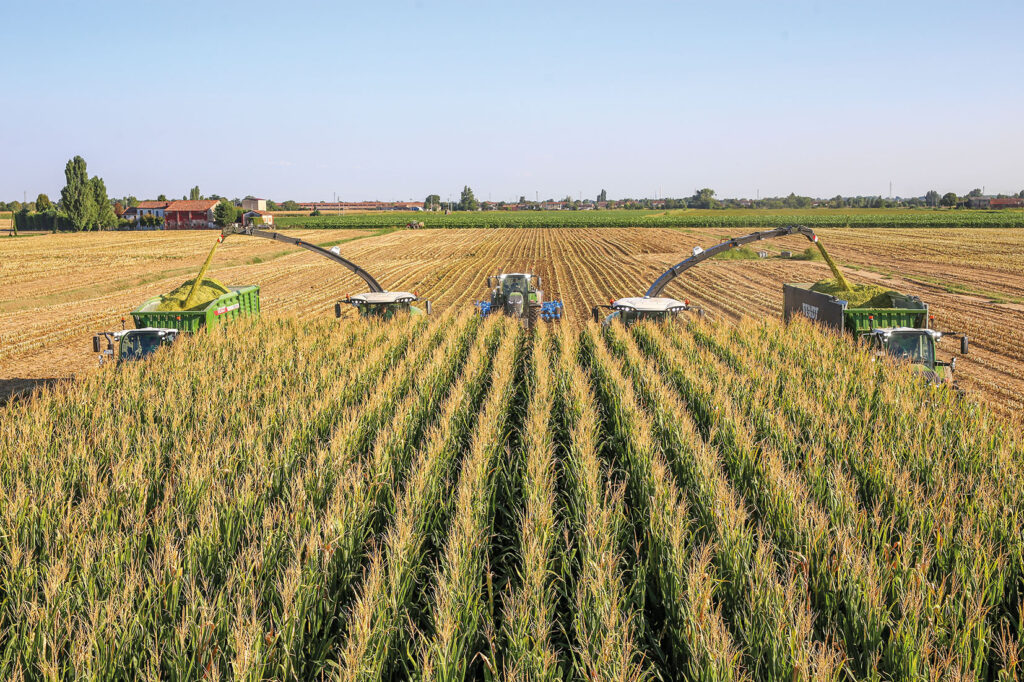New tractors and a flagship forage harvester feature at Italian press event
26th September 2022
Fendt’s best-selling 700 Vario tractor series has been expanded, with the addition of completely new seventh generation models with a longer wheelbase and more power. There is also a new, more powerful and updated Katana forage harvester. David Williams tried both machines on an Italian farm.
There are five new 700 Vario models, from 203hp to more than 300hp, and the series meets growing demand for extremely versatile tractors capable of heavy draft work and demanding transport applications, but which are also light enough for top-work, and tasks such as spray and fertiliser applications. The new models will be offered alongside the existing 6th generation 700 Vario line-up, and deliveries commence next year.
Longer wheelbase
The new models feature a 2,900mm wheelbase – significantly longer than the current 700 Vario series. This results in an even better ride, greater lift capacity and improved ability to transfer power to the ground. Despite the long wheelbase the new tractors have an incredibly tight turning radius for their size – and match the manoeuvrability of the smaller 500 Vario models. They can be supplied with a 60in track width and narrow dual wheels – for specialist row crop applications. Tyres up to 2.05m diameter can be fitted – increased from 1.95m on existing 700 Vario models. On the 726 Vario and 728 Vario, 650/85R38 rear tyres are standard and 650/65R42 tyres are an option. Fendt 720 Vario, 722 Vario and 724 Vario models feature the smaller size as standard.
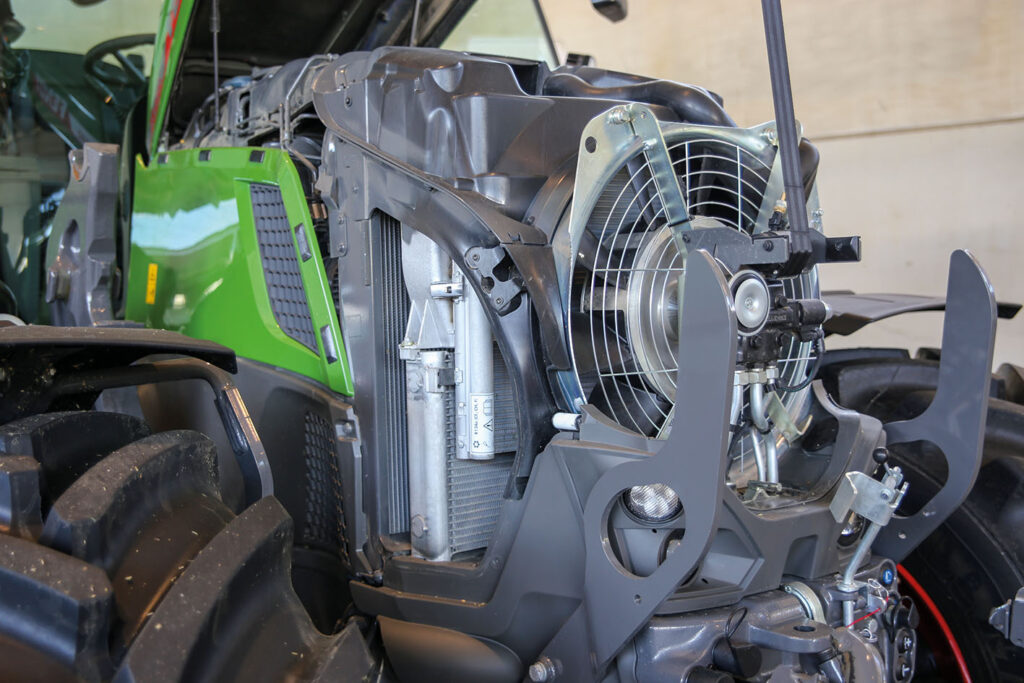
The new 700 Vario models have a completely new AgcoPower engine and a concentric cooling system.
Impressive power for size
The engine and transmission are both brand new. It is the first time that Fendt has introduced a previously unused engine and gearbox simultaneously on the same tractor.
There are five models – from 203hp (rated) to 303hp with boost, all with a new version of Fendt’s VarioDrive transmission.
Despite the long wheelbase, the tractors boast extremely compact dimensions and an impressive 30.5kg/hp power-to-weight ratio, making them particularly manoeuvrable and minimising ground pressure and compaction. Ideal weight distribution can be achieved, with ballast added front and rear up to a maximum gross vehicle weight of 15t.
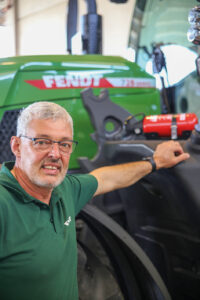
Peter Settele says that to get the best performance and economy from the new tractors, users must be familiar with the low engine speed operating concept.
New engines
The new AgcoPower 7.5-litre engines have six cylinders with four valves per cylinder and an electronically controlled turbo charger. Fendt’s proven iD low engine speed concept combines impressive productivity with miserly fuel consumption. The transmission, hydraulics and cooling system have been designed to make best use of the torque available without requiring high engine speeds. The engine idles at 700rpm, and rated power is at 1,700rpm – down from 2,100rpm on sixth generation models. Max torque is at only 1,300rpm, and the engine achieves maximum fuel efficiency across an exceptionally wide 1,200–1,700rpm speed range. With almost constant torque available between 1,150–1,500rpm, this means that the ‘sweet spot’ for operation is between 1,400–1,500rpm where near maximum power and torque are produced simultaneously.
“To get the best from the tractor, the operator has to bear in mind the low engine speed concept,” explained Fendt tractor product specialist Peter Settele. “There is no advantage to running the engine at high revs. The economy PTO setting achieves the rated output speed at 1,300rpm rather than the standard 1,650rpm, but I would only use it for implements with an extremely low power requirement, or when implements are too small for the tractor. Otherwise, there is no real benefit in terms of reducing the fuel consumption as the engine achieves maximum efficiency across the standard working speed range.”
Intelligent boost
Fendt Dynamic Performance, standard on the 728 Vario, provides the extra 20hp boost only when it is needed, but it is always available even for stationary working applications. The power demands of ancillary systems such as the cooling fan, air conditioning, lights, PTO, hydraulic pump and transmission are constantly monitored, and the engine output is uprated to compensate so that power available for the main task remains constant.
Efficient cooling
Rather than sucking air through the cooling packs, Fendt’s Concentric system pushes it through using a hydraulic-driven fan. Because the air is at ambient temperature and denser than air already warmed by the cooling packs, the system requires a lower air volume than traditional systems – reducing the fan power requirement by up to 40%. The fan speed is independent of the engine revs, and the cooling system can respond quickly if any cooling circuits require extra air flow, and the vacuum created by the fan is used to extract dust from the primary air cleaner, reducing the cleaning requirement. An automatic reversing fan is an option – helping keep the cooling packs clear of dust and debris.
The surface below the cooling packs is flat, and with no fan between, they are easily cleaned by washing or blowing out. “If it’s easy then people will do it,” stressed Peter. “Clean coolers mean improved fuel consumption as less cooling power is needed.”
An additional advantage of the Concentric fan layout is that it allows a wasp waist and a narrow engine hood, and the new 700 Vario tractors benefit from a tight 52-degree steering angle and a forward view that wouldn’t be possible with a more traditional cooling system layout.

The FendtONE control concept is standard.
New transmission
Fendt’s VarioDrive transmission concept was first used on the flagship 1000 Vario series, and the latest 900 Vario models have it too. Now, a smaller version (TA190) has been developed for the seventh generation 700 Vario series tractors.
Unlike conventional four-wheel drive systems, VarioDrive distributes torque to the front and rear axles dynamically. A single hydraulic pump powers two drive motors. One delivers uninterrupted torque through a hydro-mechanical drive to the rear axle and the other drives the front axle. An intelligent clutch distributes the torque to the axle with most traction to maximise pulling performance.
On the road, and at speeds over 25kph, the front axle drive disengages completely to reduce drag and fuel consumption.
Additional advantages of VarioDrive include pull-in-turn which increases efficiency during tight turns. Because the front and rear axles are driven independently, the system can increase the speed of the front wheels so that they pull the front of the tractor towards the steering direction. This results in an incredibly tight turning radius – demonstrated at the event by negotiating a challenging obstacle course alongside a much smaller 500 Vario model.
VarioDrive has only one operating mode and is fully automatic. On standard Vario models, users select the field or transport speed range, but this isn’t needed on the new system, and four-wheel drive is always available and engages when it will offer an advantage. During transport tasks, the system improves efficiency and safety, including when pulling away from junctions when four-wheel drive cuts in maximising traction and acceleration.
Safe transport
High-speed safety is provided by dual-circuit brakes. Fendt Reaction Steering, and a brake light and deceleration assistant. Fendt Stability Control reduces side lean at speeds above 25kph and minimises roll – also increasing operator comfort.
A new trailer braking assistant is an option. Sensors measure the thrust of the trailer and, when travelling downhill, if the trailer is pushing hard then the trailer’s pneumatic brakes are automatically activated. Trailer Brake Assist will be available from late 2023.
Hydraulic performance
Hydraulic oil flow of 165 litres/min is standard and a 220 litres/min system, with a variable displacement pump and electronic load sensing, is an option for Profi and Profi plus versions.
The new tractors are compatible with future versions of Tractor Implement Management (TIM) expected in the next few years. Extra functionality includes flow rate adjustment by the implement, increasing work rates and improving fuel economy.
Eighty litres of oil can be removed, and the tractors can have up to five valves at the rear, two at the front, plus an additional three in the middle. A new control block can be specified below the cab to supply a loader – avoiding the need to sacrifice a valve elsewhere.
Use flat-face couplings
Peter pointed out that the new tractors were all displayed with flat-face hydraulic couplings. He stressed that these should be in use on all modern farms and machinery, as they offer higher flow rates than push-in connectors, while also avoiding oil leaks and the need for messy oil containers. They are easily wiped clean and reduce oil contamination.
Cab upgrades
The VisioPlus cab has an uprated frame but looks similar to the existing version. The glass area is the same as before – offering exceptional all-around vision, especially to the front for high-level loader work where the popular curved windscreen provides a 77-degree viewing angle. A side wiper on the right-hand window maintains a clear view in wet or dusty conditions. Two optional cameras can be specified, as well as two bonnet-mounted work lights.
Operator comfort is even better than before. An increased range of six seats includes a new top-specification Isri version – with electric position adjustment plus four-way lumbar support and adjustable side bolsters, a massage function as well as heating and cooling. Seat adjustments can be made from the VarioTerminal, and users can save their preferred position and settings in the user-profile memory and re-select them with one touch of the screen.
The air conditioning system provides 30% extra cooling capacity, and an effective fridge cools drinks and food.
The updated Fendt cabs can be equipped with Cat 4 filtration for increased safety for spray applications. In its basic form, it provides protection to Cat 2 standards. Cat 4 filtration will be available from late 2023.
FendtONE
The FendtONE operating concept is standard. Control is by the multifunction joystick and optional 3L joystick. A 10in dashboard display, plus a 12in VarioTerminal on the armrest are standard, and an additional roof-mounted 12in VarioTerminal is an option.
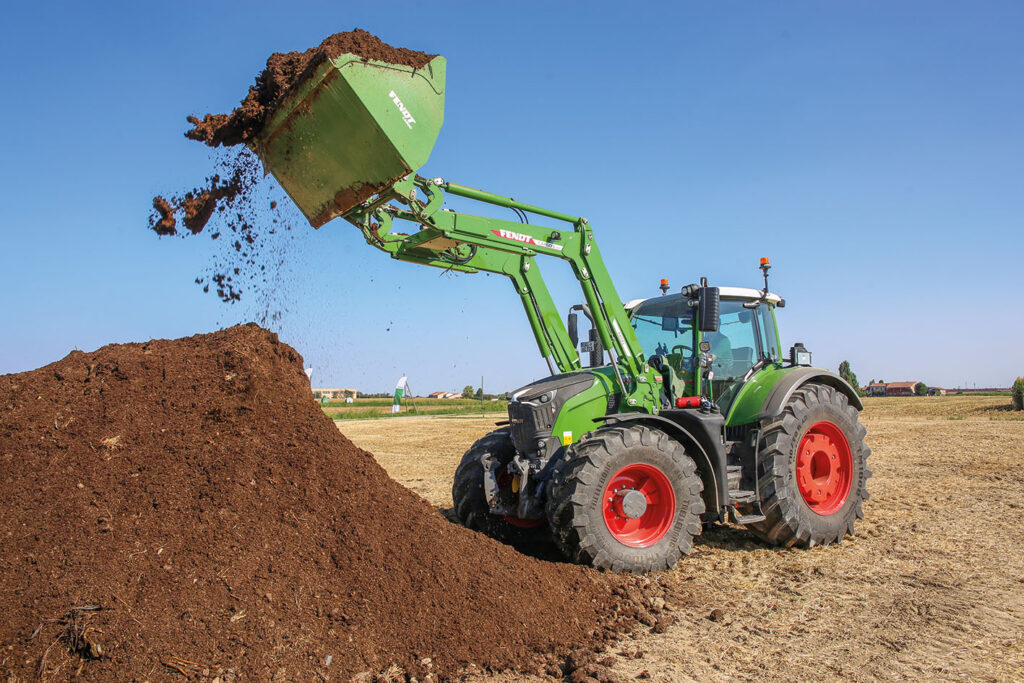
New Cargo 6.100 loaders are especially designed to suit the powerful Fendt 700 Vario tractors.
New loaders
Many 700 Vario-series tractors will be supplied with front loaders, and new Cargo and Cargo Pro 6.100 versions with a wider frame, extra strength and an upgraded mounting system have been added to the line-up. “These are designed to withstand the extra power and torque from tractors up to 300hp,” continued Peter. Maximum lift height is 4,850mm (4,460mm previously), and maximum lift capacity is 4,470daN.
Pro versions add a weighing function, and maintenance requirements based on working hours are monitored through the VarioTerminal.
Control through the optional 3L joystick allows up to three functions to operate simultaneously.
A new multi-coupler with an automatic closing cover prevents dirt ingress when the loader is removed.
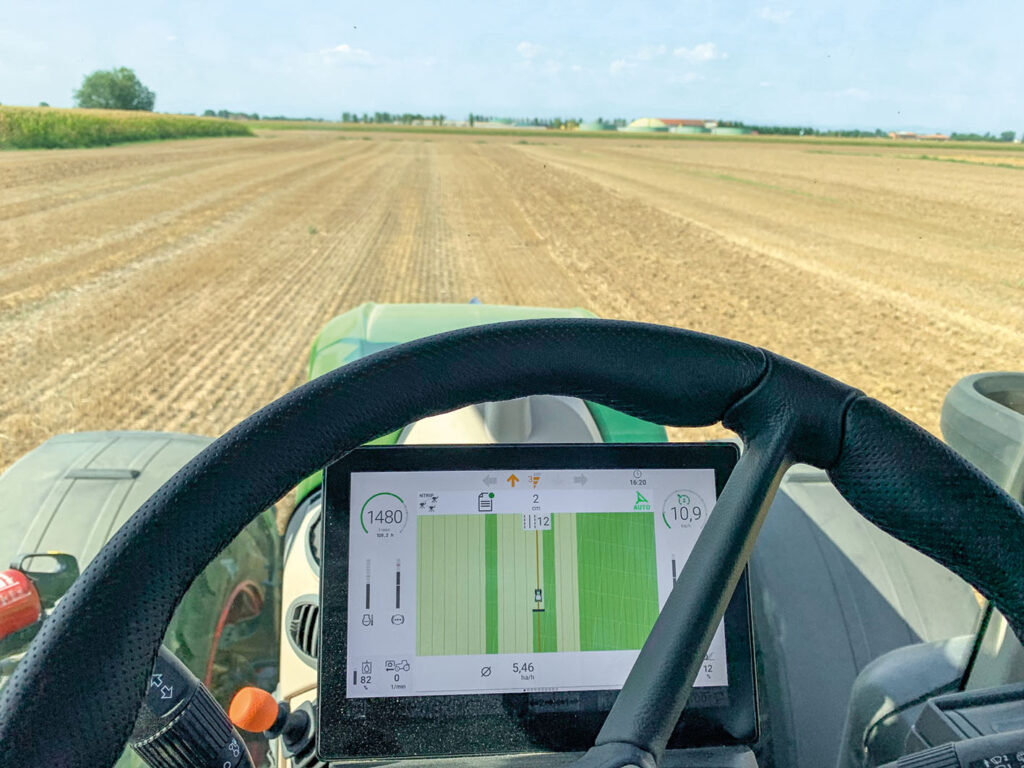
FendtONE allowed the GPS guidance and field map to be displayed on the dashboard – making it easy to view while working.
Test-drive
Farmers Guide tried the new flagship 728 Vario handling loose materials with the new Cargo 6.100 front loader, and cultivating stubble with a Lemken Karat 10, 5m heavy cultivator.
The benefits of VarioDrive transmission were immediately obvious. For loading, the manoeuvrability is exceptional for a tractor of this size as the front wheel drive engages to pull the tractor around. With no fixed ratio between the front and rear wheels, the steering is light and there is little scrubbing – which will result in a longer tyre life particularly for yard-based operations on hard surfaces.
Cultivating deep in the hard, dry conditions tested the tractor’s power and traction capabilities. During each headland turn, and when working around curves on the field headlands the steering action was always positive with little sign of front wheel slip, and although the pull-in-turn VarioDrive action is subtle and progressive it was obvious that the front wheels were doing more than just steering.
The transmission is always progressive and smooth, and there is very little operating noise. The drive engages without any delay, and precise movements are easily achieved.
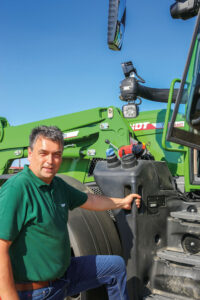
Roland Scmidt says the new seventh generation 700 Vario tractors offer excellent versatility for year-around use.
All-around vision is very good. With the new loader fully raised there is a good view of the attachment, and the narrow bonnet gives a clear view of the front wheels. For the cultivating demonstration, the seat was swivelled to the right, and it was easy to watch the front of the tractor during headland turns, while also monitoring the implement. The FendtONE displays are clear and easy to view, even in bright, sunny conditions.
The test tractor had the new Isri seat, and it was easy to achieve a comfortable working position. It provides plenty of support, and on uneven ground at higher speeds, the combination of the axle, cab and seat suspension ensures a comfortable ride.
The cultivating demonstration proved the benefits of Fendt’s iD low engine speed concept. Pulling the 5m cultivator at 11.3kph, the engine speed settled at approximately 1,450rpm. The conditions were exceptionally tough, but spot fuel consumption under full load was only 50–52 litres per hour.
Attractive new option for buyers
“Priorities for UK buyers include total cost of ownership,” explained Fendt vice president marketing, Roland Schmidt. “The new Fendt 700 Vario tractors will hold their value well, and we trialled them against all their main competitors in the field and on the road, and our arguments in terms of fuel consumption are convincing.
“We offer attractive extended warranty packages allowing customers to guarantee their ownership costs per hectare too.”
Roland said that the new tractors bridge the gap between the current sixth-generation 700 Vario series, and larger 800 Vario and 900 Vario models. “The compact size and excellent manoeuvrability make them extremely versatile, and suitable for year-around use,” he added. “All tractors are a compromise, but our new 700 Vario series is an extremely attractive option for all sorts of applications. UK dealers are very excited by the new models and believe that they will provide additional sales opportunities.”
Katana 850
Fendt has entered the 800hp-plus forage harvester market with its new flagship Katana 850. David Williams saw it prove its capabilities in an impressively heavy maize crop.
The Katana 850 has a new Liebherr 6-cyl, 18-litre engine developing 847hp, which replaces the V12 MTU power unit of the previous most powerful Katana 85. The new engine meets stage 5 emissions standards using SCR (AdBlue) only, without a DPF or EGR.
The Katana operates at full capacity with the engine speed at 1,800rpm, or for harvesting lighter crops an Eco mode can be selected. This maintains the standard 1,150rpm drum speed, but reduces the engine revs to 1,500rpm, saving fuel. The engine is mounted longitudinally within the Katana’s chassis, with a low centre of gravity for maxim stability.
“The engine is more efficient than the previous Katana 85, and lighter too,” explained Fendt UK forage harvester product specialist Dan Woodward.
An optional reversing fan with adjustable blade pitch adjusts the cooling performance to suit the conditions. The automatic reversing function can be set to operate each time the engine revs reduce – keeping the cooling pack clear of debris while leaving the operator free to concentrate on the harvesting process.
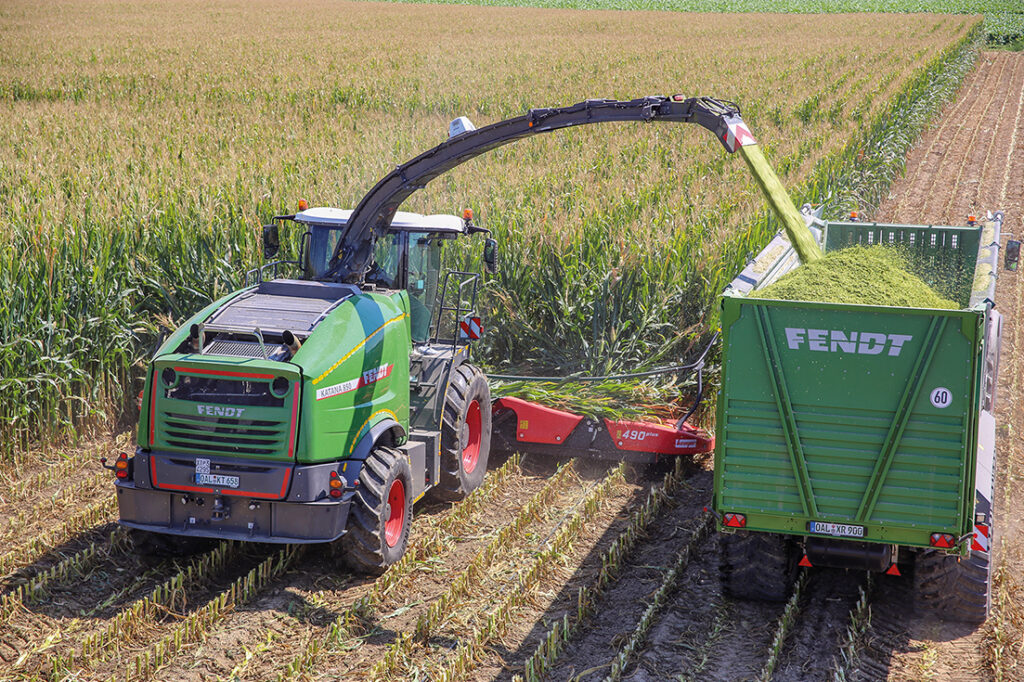
The Katana 850 equipped with a Kemper 12-row header performed well in the extremely heavy maize crop.
Optimised crop flow
The Katana’s crop feed system achieves a uniform flow through the machine. A new 12-row Kemper 490-plus maize header is available to fully utilise the harvester’s performance and optimise work rates. The header is suspended on the Katana’s pendulum mounting frame which allows it to pivot up to 14 degrees in either direction to optimise ground-following capability.
The header speed can be fixed or set to adjust automatically.
From the header, the crop passes through six pre-compression rollers in the feed intake. These compress the crop and hold it securely as it enters the drum, ensuring consistent chop length. Metal and stone detectors in the first feed rollers, 920mm in front of the drum, allow plenty of time to stop the flow and prevent damage.
The Katana’s chopping drum is the industry’s largest at 720mm diameter, and it can be fitted with 20, 28 or 40 knives for a chop length from 2.6–41.4mm. The knife sharpening system continually adjusts the stone during use, so that the entire blade width is sharpened gently and evenly. This maintains optimal chopping performance and maximises the blade working life. The blades are mounted on slotted holes and can be repositioned so that the entire length is utilised.
Chop length is controlled by the rotation speed of the six feed rollers, through a gearbox with two speed ranges and a hydraulic drive with two virtual ranges.
Fendt’s range of 300mm diameter crackers includes an R version with a sawtooth profile, and the RS with a V spiral groove. Speed differentials of 30 and 40% are available.
A manual winding system moves the cracker in and out of its working position.
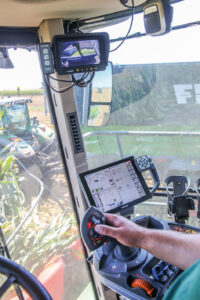
Control appearance and layout is similar to Fendt tractors.
Crop handling
The revised discharge chute has a 210-degree swivel angle and a maximum loading height of 6.2m making it suitable for use with the largest trailers. Optional Fendt Fill Control automatically adjusts the discharge flap as the chute rotates, so that forage is delivered to the same central point across the trailer. A chute-mounted camera provides a clear view of the crop entering the trailer.
Crop nutrient sensing is available through the optional IT-Photonics NIR sensor. Connection is through Isobus and, as well as monitoring crop quality, it also measures crop flow and provides yield estimates. Crop data can be transferred wirelessly from the machine, through VarioDoc Pro and Agrirouter.
When it isn’t required for harvesting, the NIR sensor can be mounted on a slurry applicator for constituent analysis instead.
Test drive
The farm in northern Italy proved an excellent location for the harvesting demonstration, with maize standing as high as the top of the Katana’s cab and yielding up to 108t/ha. With the 8m, 12-row, Kemper 490 Plus header, and set to achieve a 5mm chop length, the Katana harvested 180–205t/hr, travelling at 3kph, at an engine speed of 1,850rpm. The spot-rate diesel consumption was impressively low at 41 litres per hour, in the damp heavy crop.
Cab noise levels are extremely low. The air conditioning maintained a cool cab even though it was approximately 40ºC outside.
Advantages of the Katana’s design include cruise control which allows the user to set a maximum engine working load which is maintained automatically by adjusting the travel speed, and the unblocking process which allows the feed rollers to be reversed without the table feed reversing at the same time – preventing the crop being ejected out onto the field.
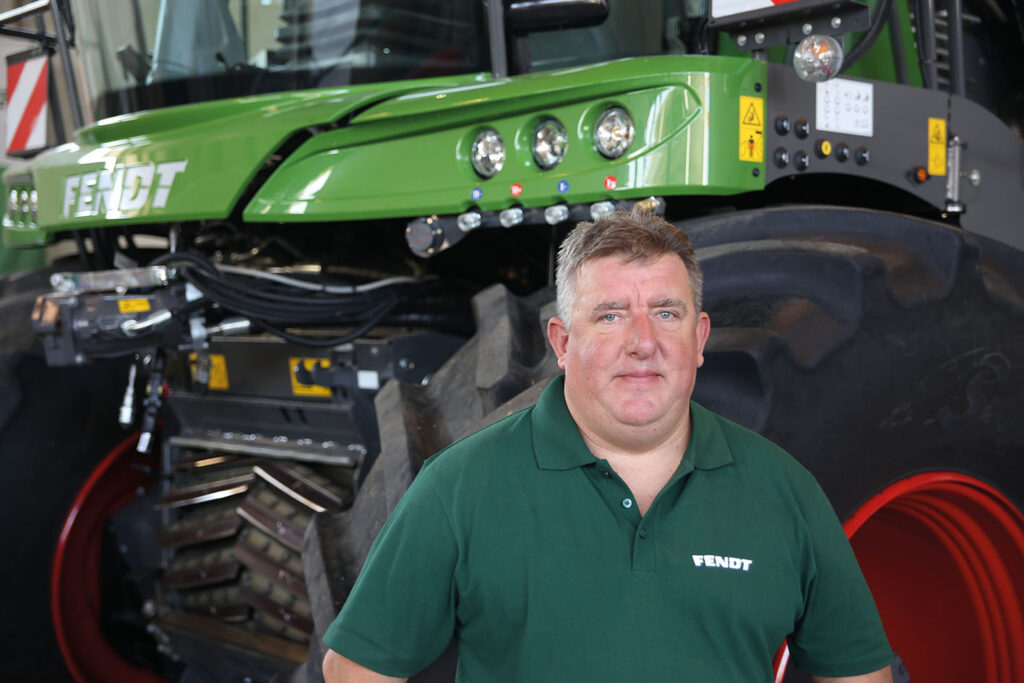
Fendt forage harvester product specialist, Dan Woodward.
“The improved crop flow system transformed the smaller Katana when it was upgraded from the 65 to the 650, and the same system will benefit owners of the new 850 too,” explained Dan. “We expect sales to be split equally between the two models, with the new 850 likely to be selected by those with large areas of maize and wholecrop.
“Limited production of the Katana 850 starts in April next year, and we will be running demonstration machines of both sizes during the grass and maize harvesting seasons.
“Increased productivity combined with significant fuel savings makes both models very attractive, and the cab is extremely comfortable too.”
